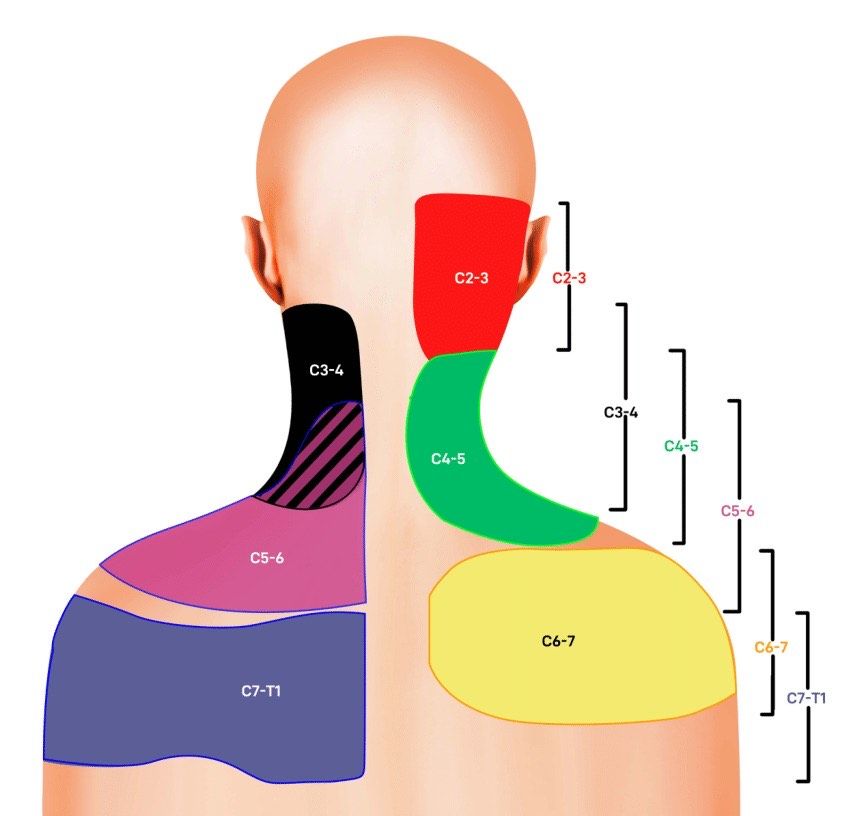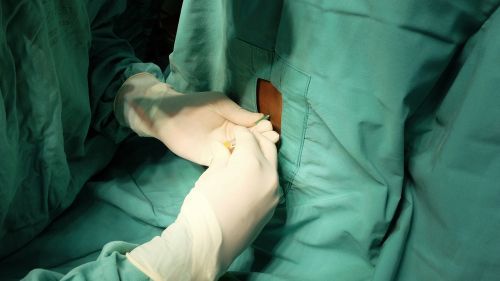Cervical Facet Injection
Cervical Facet injection
For Neck Pain & Headache
A cervical facet injection is an outpatient procedure for treating headaches, and neck, shoulder, and upper back pain. This information sheet will explain what it is. Your doctor can explain if it is for you.
What are cervical facet joints?
Facet joints connect the vertebrae, the bones of the spine. They help guide your spine when you move. The neck area of the spine is called the cervical region. It contains seven vertebrae. Facet joints are found on both sides of the spine. Each is about the size of a thumbnail. Cervical facet joints are named for the vertebrae they connect and the side of the spine where they are found. The right C2-3 facet joint, for example, joins the 2nd and 3rd vertebrae on the right side.

What is cervical facet joint pain?
You may feel pain if a cervical facet joint is injured or infamed. Sometimes it feels like muscle tension. Other times it can be severe pain. The cartilage inside the joint may be injured. Other times only connecting ligaments or nerves surrounding the joint are injured. Facet pain also depends on which facet joint is affected. Cervical facet pain can occur in an area from your head down to your shoulder blade. The diagram shows areas of pain usually associated with specifc joints.
How do I know if I have cervical facet pain?
If you have pain in one or more of these areas that worsens when you turn your head you may have cervical facet pain. Common tests such as x-rays or MRIs may not always show if a facet joint is causing pain.
What is a cervical facet injection?
In a cervical facet injection, a local anesthetic (numbing medicine) and corticosteroid (healing medicine) are injected into one or more of your cervical facet joints. The injection can be used to diagnose and/or treat. A local anesthetic (numbing medicine) and corticosteroid (healing medicine) may be injected to see if they temporarily lessen your pain. If they do, and if this helps you move better, it tells the doctor which facet joint is causing the pain. The corticosteroid (healing medicine) is used to treat infammation of the facet joint.
What happens during an injection?
The injection may start with an IV (medicine given intravenously) to help you relax and put you into a twilight sleep. A local anesthetic (numbing medicine) will be used to numb your skin. The doctor will then insert a thin needle directly into the facet joint. Fluoroscopy, a type of x-ray, may be used to ensure the safe and proper position of the needle. A dye may also be injected to make sure the needle is at the correct spot. When the doctor is sure the needle is at the correct place, the anesthetic and corticosteroid will be injected.
What happens after an injection?
You will be monitored for at least 30 minutes after the injection. When you are ready to leave, the clinic will give you discharge instructions. Keeping track of your pain helps your doctor know what the next steps are for your care. It may help to move your neck in ways that hurt before the injection, to see if the pain is still there, but do not overdo it. Take it easy for the rest of the day. You may feel immediate pain relief and numbness in your neck for up to six hours after the injection. Your pain may return after this short pain-free period, or may even be a little worse for a day or two. This is normal. It may be caused by needle irritation or by the corticosteroid itself. Corticosteroids usually take one or two days to start working, but can take as long as a week. You can usually return to work the day after the injection, but always check with your doctor.
How long can I expect pain relief?
You will be monitored for at least 30 minutes after the injection. When you are ready to leave, the clinic will give you discharge instructions. Keeping track of your pain helps your doctor know what the next steps are for your care. It may help to move your neck in ways that hurt before the injection, to see if the pain is still there, but do not overdo it. Take it easy for the rest of the day. You may feel immediate pain relief and numbness in your neck for up to six hours after the injection. Your pain may return after this short pain-free period, or may even be a little worse for a day or two. This is normal. It may be caused by needle irritation or by the corticosteroid itself. Corticosteroids usually take one or two days to start working, but can take as long as a week. You can usually return to work the day after the injection, but always check with your doctor.
Cervical Facet injection
The extent and duration of pain relief may depend on the amount of disc, dural, or nerve root inflammation. Other coexisting factors may be responsible for your pain. Sometimes an injection brings several weeks to months of pain relief, and then further treatment is needed. Other times, a single injection brings long-term pain relief. If your pain is caused by injury to more than one area, only some of your symptoms will be helped by a single injection.
What Are Cervical Facet Joints?
Facet joints connect the vertebrae, the bones of the spine. They help guide your spine when you move. The neck area of the spine is called the cervical region. It contains seven vertebrae. Facet joints are found on both sides of the spine. Each is about the size of a thumbnail. Cervical facet joints are named for the vertebrae they connect and the side of the Facet Cartilage spine where they are found. The left C2-3 facet joint, for example, joins the 2nd and 3rd vertebrae on the left side.
What Is Cervical Facet Joint Pain?
You may feel pain if a cervical facet joint is injured. Sometimes it feels like muscle tension. Other times it can be severe pain. The cartilage inside the joint may be injured. Other times only connecting ligaments surrounding the joint are injured.Facet pain also depends on which facet joint is affected. Cervical facet pain can occur in an area from your head down to your lower shoulder blade. The diagram on the top right shows areas of pain usually associated with specific joints.

What Happens After An Injection?
You will be monitored for up to 30 minutes after the injection. When you are ready to leave, the staff will give you discharge instructions. You will also be given a pain diary. It is important to fill this out because it helps your doctor know how the injection is working. It will help to move your neck in ways that hurt before the injection, to see if the pain is still there, but do not overdo it. Take it easy for the rest of the day. You may feel immediate pain relief and numbness in your neck for a period of time after the injection. This may indicate the medication has reached the right spot. Your pain may return after this short pain-free period, or may even be a little worse for a day or two. It may be caused by needle irritation or by the corticosteroid itself. Corticosteroids usually take two or three days to start working, but can take as long as a week. You can usually return to work the day after the injection, but always check with your doctor.
How Long Can I Expect Pain Relief?
The extent and duration of pain relief may depend on the amount of inflammation and how many areas are involved. Other coexisting factors may be responsible for your pain. Sometimes an injection can bring several weeks to months of pain relief, and then more treatment is needed. Other times, particularly if there is no underlying bone or joint problem, one injection brings long- term pain relief. If your pain is caused by injury to more than one area, only some of your symptoms may be helped by one injection.
